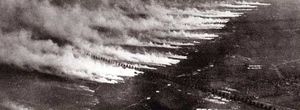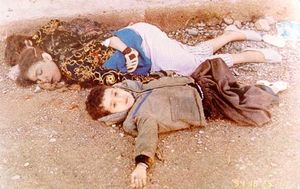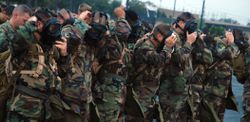الحرب الكيماوية
| جزء من سلسلة عن | ||||||||||
| العوامل الكيميائية | ||||||||||
|---|---|---|---|---|---|---|---|---|---|---|
| العوامل القاتلة | ||||||||||
|
||||||||||
| عوامل تعجيز | ||||||||||
|
||||||||||
الحرب الكيميائية Chemical warfare (CW)، حي حرب يستخدم فيها الخصائص السمية للمواد الكيميائية كأسلحة. هذا النوع من الحروب يختلف عن الحرب النووية والحرب البيولوجية، واللذان يندرجا تحت الحرب الكيماوية البيولوجية الإشعاعي، وجميعهم من "أسلحة الدمار الشامل". هذه الأسلحة جميعها ليست ضمن الأسلحة التقليدية والتي ترجع فعاليتها يصفة أساسية لقدرتها التدميرية المحتملة. لا تعتمد الحرب الكيميائية في إصابة الأهداف على قوة التفجير. لكنها بدلاً عن ذلك تعتمد على الخصائص الفريدة للعامل الكيميائي المستخدم كسلاح. تم تصميم هذا العامل لإصابة أو شل حركة العدو، أو استخدامه بصورة أوسع في منطقة جغرافية محددة. يمكن أيضاً استخدامه على المزروعات والماشية لتحفيز إحساس الجوع لديها وتركها تموت جوعاً. مع معدات الحماية المناسبة، التدريب، تدابير إزالة التلوث، يمكن التغلب على التأثيرات الأولية للأسلحة الكيميائية.
التعريف
التكنولوجيا
| العوامل | الانتشار | الحماية | التحقق | |
|---|---|---|---|---|
| 1914 | الكلورين Chloropicrin الفوسجين غاز الخردل |
النثر في الهواء | أقنعة الغاز، urinated-on gauze | الاستشناق |
| 1918 | Lewisite | الدروع الكيميائية | قناع الغاز وضع زيت الصنوبر على الملابس |
smell of geraniums |
| ع 1920 | Projectiles w/ central bursters | CC-2 clothing | ||
| ع 1930 | عوامل المجموعة دي العصبية | قنابل الطائرات | Blister agent detectors يغير لون الورق | |
| ع 1940 | Missile warheads Spray tanks |
Protective ointment (mustard) Collective protection Gas mask w/ Whetlerite |
||
| ع 1950 | ||||
| ع 1960 | عوامل السلسلة ڤي العصبية | عن طريق الهوائ | Gas mask w/ water supply | Nerve gas alarm |
| ع 1970 | ||||
| ع 1980 | Binary munitions | قناعات الغاز المتطورة (protection, fit, comfort) |
Laser detection | |
| ع 1990 | Novichok nerve agents |

عوامل الحرب الكيميائية
 مقالة مفصلة: قائمة عوامل الحرب الكيميائية
مقالة مفصلة: قائمة عوامل الحرب الكيميائية
الثبات
الأنواع
| نوع العامل | أسماء العامل | التأثير | الأعراض والعلامات | معدل التأثير | الثبات |
|---|---|---|---|---|---|
| الأعصاب |
|
Inactivates enzyme acetylcholinesterase, preventing the breakdown of the neurotransmitter acetylcholine in the victim's synapses and causing both muscarinic and nicotinic effects |
|
VX is persistent and a contact hazard; other agents are non-persistent and present mostly inhalation hazards. | |
| Asphyxiant/Blood |
|
|
Immediate onset | Non-persistent and an inhalation hazard. | |
| Vesicant/Blister |
|
Agents are acid-forming compounds that damages skin and respiratory system, resulting burns and respiratory problems. |
|
|
Persistent and a contact hazard. |
| Choking/Pulmonary | Similar mechanism to blister agents in that the compounds are acids or acid-forming, but action is more pronounced in respiratory system, flooding it and resulting in suffocation; survivors often suffer chronic breathing problems. |
|
Immediate to 3 hours | Non-persistent and an inhalation hazard. | |
| Lachrymatory agent | Causes severe stinging of the eyes and temporary blindness. | Powerful eye irritation | Immediate | Non-persistent and an inhalation hazard. | |
| Incapacitating |
|
Causes atropine-like inhibition of acetylcholine in subject. Causes peripheral nervous system effects that are the opposite of those seen in nerve agent poisoning. |
|
|
Extremely persistent in soil and water and on most surfaces; contact hazard. |
| Cytotoxic proteins |
Non-living biological proteins, such as: |
Inhibit protein synthesis |
|
4-24 hours; see symptoms. Exposure by inhalation or injection causes more pronounced signs and symptoms than exposure by ingestion | Slight; agents degrade quickly in environment |
طرق التسمية
| عوامل الدم: | مبثرات: |
|---|---|
|
|
| عوامل التنفس: | عوامل التعجيز: |
|
|
| عوامل مسيلة للدموع: | عوامل الأعصاب: |
|
طريقة الاستخدام
الضخ
النثر الحراري
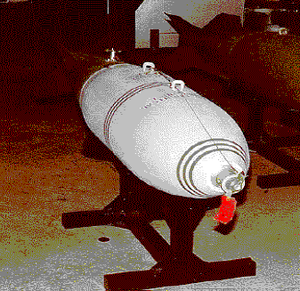

النثر في الهواء
الحماية ضد الحرب الكيميائية
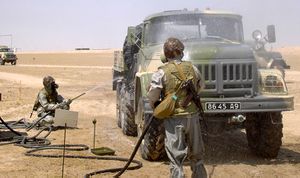
التطهير
المناخ الاجتماعي السياسي
الجهود الرمية للقضاء على الحرب الكيميائية
| البلد | تمتلك أسلحة كيميائية | وقعت اتفاقية الأسلحة الكيميائية | صدقت على اتفاقية الأسلحة الكيميائية |
|---|---|---|---|
| ألبانيا | معروف | 14 يناير 1993 | 11 مايو 1994 |
| بورما (ميانمار) | مرجح | 13 يناير 1993 | لا |
| الصين | مرجح | 13 يناير 1993 | 4 أبريل 1997 |
| مصر | مرجح | لا | لا |
| الهند | معروف | 14 يناير 1993 | 3 سبتمبر 1996 |
| إيران | معروف | 13 يناير 1993 | 3 نوفمبر 1997 |
| إسرائيل | محتمل | 13 يناير 1993 | لا |
| اليابان | مرجح | 13 يناير 1993 | 15 سبتمبر 1995 |
| ليبيا | معروف | لا | 6 يناير 2004 (انضمت) |
| كوريا الشمالية | معروف | لا | لا |
| پاكستان | مرجح | 13 يناير 1993 | 28 أكتوبر 1997 |
| روسيا | معروف | 13 يناير 1993 | 5 نوفمبر 1997 |
| صربيا والجبل الأسود |
مرجح | لا | 20 أبريل 2000 (انضمت) |
| السودان | محتمل | لا | 24 مايو 1999 (انضمت) |
| سوريا | معروف | لا | لا |
| تايوان | محتمل | n/a | n/a |
| الولايات المتحدة | معروف | 13 يناير 1993 | 25 أغسطس 1997 |
| ڤيتنام | مرجح | 13 يناير 1993 | 30 سبتمبر 1998 |
انتشار الأسلحة الكيميائية
التاريخ
| الحرب |
|---|
| التاريخ العسكري |
| العصور |
|
قبل التاريخ • القديمة • الوسيطة |
| مجالات المعارك |
| أسلحة |
|
مدرعات • مدفعية • بيولوجية • سلاح الفرسان |
| تكتيكات |
| استراتيجية |
| التنظيم |
| الإمداد |
| القوائم |
|
المعارك • القادة • العمليات |
العصور القديمة والعصور الوسطى
الأدلة النصية والأدبية
الأدلة الأثرية
اعادة الاكتشاف
الحرب العالمية الأولى
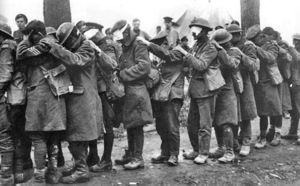
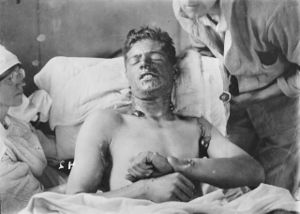
سنوات بين الحربين
إستخدام غاز إيطاليا الفاشية غاز الخردل في إثيوپيا عام 1935
ألمانيا
الحرب العالمية الثانية
استخدام الجيش الامبراطوري الياباني لعوامل النفط في الصين عام 1937
أسباب عدم إستخدام ألمانيا النازية الغاز السام في الحرب العالمية الثانية
الاستخدام المحتمل للغاز السام في القرم من قبل الڤرماخت الألمان عام 1942
الإنطلاق العرضي لغاز الخردل بعد قصف الألمان لباري عام 1943
اليمن الشمالي
وقع أول هجوم في الحرب الأهلية باليمن الشمالي في 8 يونيو 1963 على الكومة، قرية يقطنها حوالي 100 نسمة في شمال اليمن، وقُتل حوالي سبعة اشخاص وأصيب 25 آخرين بإصابات في العينين والرئتين. يعتبر هذا الحادث تجريبياً، ووصفت القنابل على أنها "منزلية الصنع"، بطريقة غير إحترافية وذات أثر محدود نسبياً". اعتقدت السلطات المصرية أن تلك الحوادث كانت نتيجة استخدام الناپالم وليس الغاز.
لا يوجد تقارير عن استخدام الغاز عام 1964، ولكن ظهرت بعض التقارير عام 1965. وازدادت تلك التقارير في أواخر 1966. في 11 ديسمبر 1966، قتلت 15 قنبلة غاز شخصين وجرحت 35. في 5 يناير 1967، وقع أكبر هجوم بالغز على قرية قطاف، راح ضحيته 270 شخص، منهم 140 قتيل. يحتمل أن الهدف كان الأمير حسن بن يحيى، الذي كان مقر إقامته على مقربة من موقع الهجوم. أنكرت الحكومة المصرية استخدام الغاز السام، وزعمت أن البريطانيين والأمريكان استخدما التقارير كنوع من أنواع الحرب النفسية على مصر. في 12 فبراير 1967، صرحت مصر أنها ترحب بتحقيقات الأمم المتحدة. في 1 مارس، صرح يو ثانت أنه كان "عاجز" عن التعامل مع الأمر.
في 10 مارس، ألقيت قنابل الغاز على قريتي الجهار والجدفة في وادي حيران، حيث مقر الأمير محمد بن محسن، قُتل 75 شخص على الأقل. صدر تحذير من الصليب الأحمر وفي 2 يونيو، وأصدر بيان يعرف فيه عن قلق جنيڤ. معهد فورنسيك للطب في جامعة بيرن، أصدر بيان، معتمداً على تقرير الصليب الأحمر، جاء فيه أن الغاز المستخدم قد يكون من مشتقات الهالوجين - الفوسجين، غاز الخردل، اللويزيت، الكلوريد أو بروميد الكيانوجين.
توقفت هجمات الغاز لثلاثة اسابيع بعد حرب يونيو 1967، لكنها استؤنفت في يوليو، على المناطق الملكية في اليمن. اختلفت تقديرات أعداد الضحايا، وفي افتراض، يمكن اعتباره محافظاً، أن قنابل الخردل أو الفوسجين تسببت في مقتل 1.500 شخص وإصابة 1.500 آخرين.[بحاجة لمصدر]
الحرب الباردة
تطويرات الحكومة الغربية
حرب مبيدات الأعشاب
 مقالة مفصلة: حرب مبيدات الأعشاب
مقالة مفصلة: حرب مبيدات الأعشاب
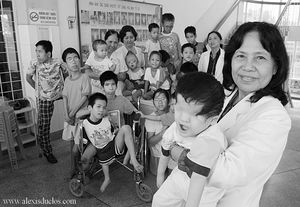
المعايير الأمريكية لحماية الجهاز التنفسي
تقرير مجلس الشيوخ الأمريكي
مشروع شاد
تطويرات الحكومة السوڤيتية
الحرب الإيرانية العراقية
The Iran–Iraq War began in 1980 when Iraq attacked Iran. Early in the conflict, Iraq began to employ mustard gas and tabun delivered by bombs dropped from airplanes; approximately 5% of all Iranian casualties are directly attributable to the use of these agents.[بحاجة لمصدر]
Chemical weapons employed by Saddam Hussein killed and injured numerous Iranians, and possibly Iraqis. According to Iraqi documents, assistance in developing chemical weapons was obtained from firms in many countries, including الولايات المتحدة، West Germany, هولندا, the المملكة المتحدة, and France.[2]
About 100,000 Iranian soldiers were victims of Iraq's chemical attacks. Many were hit by mustard gas. The official estimate does not include the civilian population contaminated in bordering towns or the children and relatives of veterans, many of whom have developed blood, lung and skin complications, according to the Organization for Veterans. Nerve gas agents killed about 20,000 Iranian soldiers immediately, according to official reports. Of the 80,000 survivors, some 5,000 seek medical treatment regularly and about 1,000 are still hospitalized with severe, chronic conditions.[3][4][5]
Shortly before war ended in 1988, the Iraqi Kurdish village of Halabja was exposed to multiple chemical agents, killing about 5,000 of the town's 50,000 residents.[6]
During the Gulf War in 1991, Coalition forces began a ground war in Iraq. Despite the fact that they did possess chemical weapons, Iraq did not use any chemical agents against coalition forces. The commander of the Allied Forces, Gen. H. Norman Schwarzkopf, suggested this may have been due to Iraqi fear of retaliation with nuclear weapons.[بحاجة لمصدر]
حرب فلاندرز
الارهاب
معاهدة الأسلحة الكيميائية

القضاء على الأسلحة الكيميائية
الهند
العراق
The Director-General of the Organisation for the Prohibition of Chemical Weapons, Ambassador Rogelio Pfirter, welcomed Iraq's decision to join the OPCW as a significant step to strengthening global and regional efforts to prevent the spread and use of chemical weapons. The OPCW announced "The government of Iraq has deposited its instrument of accession to the Chemical Weapons Convention with the Secretary General of the United Nations and within 30 days, on 12 February 2009, will become the 186th State Party to the Convention". Iraq has also declared stockpiles of chemical weapons, and because of their recent accession is the only State Party exempted from the destruction time-line.[7]
اليابان
روسيا
الولايات المتحدة
انظر أيضاً
- اتفاقية الأسلحة الكيميائية 1990
- علي حسن المجيد
- منطقة منزوعة السلاح
- حرب بيولوجية
- معاهدة الأسلحة الكيميائية
- تسمية الأسلحة الكيميائية
- الأسلحة الكيميائية والمملكة المتحدة
- Exotic pollution
- Lethal Unitary Chemical Agents and Munitions
- قائمة عوامل الأسلحة الكيميائية
- قائمة الغازات عالية السمية
- عملية القبعة الحمراء
- رونالد مايسدون
- أسلحة نفسية كيميائية
- نصب القديس جولين
- سارداشت (مدينة هوجمت بالأسلحة الكيميائية أثناء الحرب الإيرانية العراقية)
- Stink bomb
- United States Army Medical Research Institute of Chemical Defense
- أسلحة الدمار الشامل
- زيلكون بي
الهوامش
- ^ Getipm.com
- ^ Lafayette, Lev (July 26, 2002), "Who armed Saddam?", World History Archives, http://www.hartford-hwp.com/archives/51/040.html
- ^ Fassihi, Farnaz (October 27, 2002), "In Iran, grim reminders of Saddam's arsenal", New Jersey Star Ledger, http://www.nj.com/specialprojects/index.ssf?/specialprojects/mideaststories/me1209.html
- ^ Hughes, Paul (2003), "It's like a knife stabbing into me", The Star (South Africa), http://www.thestar.co.za/index.php?fArticleId=39470
- ^ Sciolino, Elaine (February 13, 2003), "Iraq Chemical Arms Condemned, but West Once Looked the Other Way", New York Times, http://www.commondreams.org/headlines03/0213-05.htm
- ^ Death Clouds: Saddam Hussein’s Chemical War Against the Kurds
- ^ "Iraq Joins the Chemical Weapons Convention". Opcw.org. Retrieved 2011-09-16.
المصادر
- CBWInfo.com (2001). A Brief History of Chemical and Biological Weapons: Ancient Times to the 19th Century. Retrieved Nov. 24, 2004.
- Chomsky, Noam (Mar. 4, 2001). Prospects for Peace in the Middle East, page 2. Lecture.
- Cordette, Jessica, MPH(c) (2003). Chemical Weapons of Mass Destruction. Retrieved Nov. 29, 2004.
- Croddy, Eric (2001), Chemical and Biological Warfare, Copernicus, ISBN 0-387-95076-1
- Smart, Jeffery K., M.A. (1997). History of Biological and Chemical Warfare. Retrieved Nov. 24, 2004.
- United States Senate, 103d Congress, 2d Session. (May 25, 1994). The Riegle Report. Retrieved Nov. 6, 2004.
- Gerard J Fitzgerald. American Journal of Public Health. Washington: Apr 2008. Vol. 98, Iss. 4; p. 611
قراءات إضافية
- Leo P. Brophy and George J. B. Fisher; The Chemical Warfare Service: Organizing for War Office of the Chief of Military History, 1959; L. P. Brophy, W. D. Miles and C. C. Cochrane, The Chemical Warfare Service: From Laboratory to Field (1959); and B. E. Kleber and D. Birdsell, The Chemical Warfare Service in Combat (1966). official US history;
- Gordon M. Burck and Charles C. Flowerree; International Handbook on Chemical Weapons Proliferation 1991
- L. F. Haber. The Poisonous Cloud: Chemical Warfare in the First World War Oxford University Press: 1986
- James W. Hammond Jr; Poison Gas: The Myths Versus Reality Greenwood Press, 1999
- Jiri Janata, Role of Analytical Chemistry in Defense Strategies Against Chemical and Biological Attack, Annual Review of Analytical Chemistry, 2009
- Ishmael Jones, The Human Factor: Inside the CIA's Dysfunctional Intelligence Culture, Encounter Books, New York 2008, revised 2010, ISBN 978-1-59403-382-7. WMD espionage.
- Benoit Morel and Kyle Olson; Shadows and Substance: The Chemical Weapons Convention Westview Press, 1993
- Adrienne Mayor, "Greek Fire, Poison Arrows & Scorpion Bombs: Biological and Chemical Warfare in the Ancient World" Overlook-Duckworth, 2003, rev ed with new Introduction 2008
- Geoff Plunkett, Chemical Warfare in Australia: Australia's Involvement In Chemical Warfare 1914 - Today, (2nd Edition), 2013.. Leech Cup Books. A volume in the Army Military History Series published in association with the Army History Unit.
- Jonathan B. Tucker. Chemical Warfare from World War I to Al-Qaeda (2006)
وصلات خارجية
- Chemical weapons and international humanitarian law
- ATSDR Case Studies in Environmental Medicine: Cholinesterase Inhibitors, Including Insecticides and Chemical Warfare Nerve Agents U.S. Department of Health and Human Services
- Russian Biological and Chemical Weapons, about the danger posed by non-state weapons transfers
- Gaddum Papers at the Royal Society
- Chemical Weapons stored in the United States
- The Organisation for the Prohibition of Chemical Weapons OPCW
- Chemical Warfare in Australia
- Classes of Chemical Agents U.S. National Library of Medicine
- Chemical warfare agent potency, logistics, human damage, dispersal, protection and types of agents (bomb-shelter.net)
- "'War of Nerves': A History of Chemical Weapons" (interview with Jonathan Tucker from National Public Radio Talk of the Nation program, May 8, 2006
- Chemical weapons in World War II
- "Our Army's Defense Against Poison Gas". Popular Science, February 1945, pp. 106–111.

